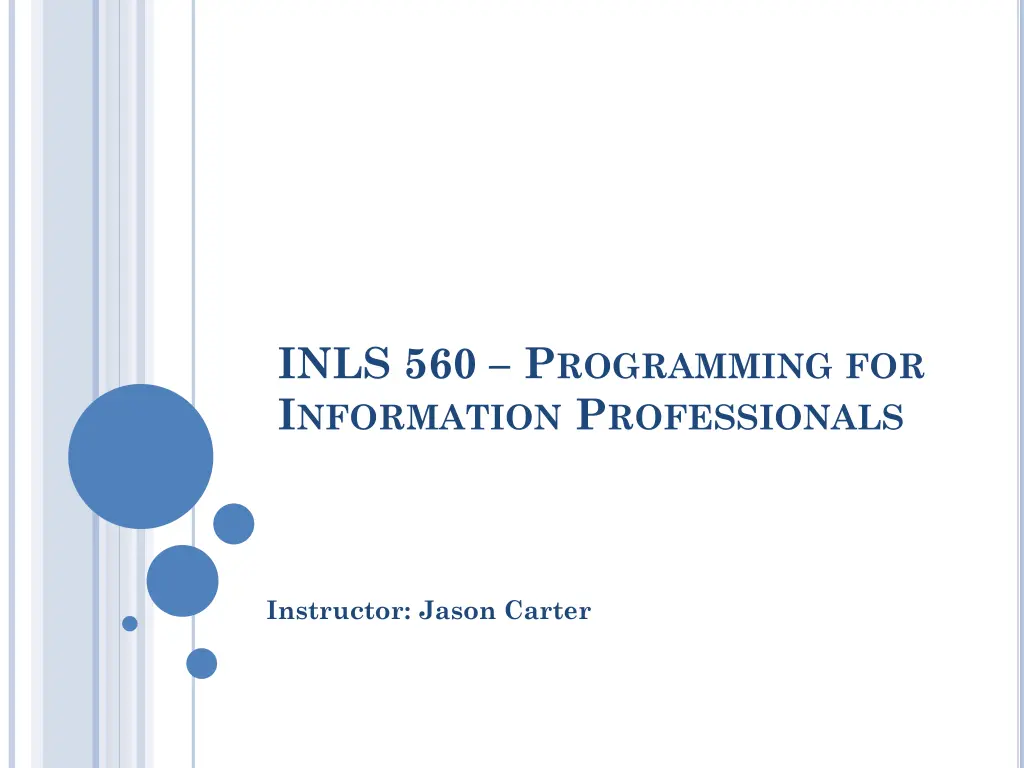
Programming for Information Professionals with INLS 560
Learn about programming for information professionals with INLS 560, instructed by Jason Carter. Explore the basics of programming, including what a program is, how computers understand languages, machine language challenges, and ways to overcome them. Discover essential concepts such as instructions, machine language, and the importance of clear communication with computers.
Download Presentation

Please find below an Image/Link to download the presentation.
The content on the website is provided AS IS for your information and personal use only. It may not be sold, licensed, or shared on other websites without obtaining consent from the author. If you encounter any issues during the download, it is possible that the publisher has removed the file from their server.
You are allowed to download the files provided on this website for personal or commercial use, subject to the condition that they are used lawfully. All files are the property of their respective owners.
The content on the website is provided AS IS for your information and personal use only. It may not be sold, licensed, or shared on other websites without obtaining consent from the author.
E N D
Presentation Transcript
INLS 560 PROGRAMMING FOR INFORMATION PROFESSIONALS Instructor: Jason Carter
A PROGRAM Set of instructions that a computer follows to perform a task or solve a problem
PIAZZA Signup Link: piazza.com/unc/fall2014/560 Class page: piazza.com/unc/fall2014/560/home
WHAT IS A PROGRAM? Set of instructions that a computer follows to perform a task or solve a problem
WHAT DID WE LEARN FROM THIS EXERCISE? Computers are dumb! Computers only do what you tell them to do. Computers do what you tell them to do really fast, so they appear smart (but they are not). Computers don t remember anything unless you tell them how to remember. Computers take your instructions literally. If you tell them to do something dumb, they do it. Computers only do what they are told and in exactly the order you tell them.
WHAT LANGUAGE DO COMPUTERS UNDERSTAND? A computer understands 1 s and 0 s Sequences of 1 s and 0 s CPU (Central Processing Unit) Reads instructions from memory Decodes fetched instruction to determine which operation to perform Perform the operation Operation Examples: reading data, adding, subtracting, multiplying, and dividing numbers
MACHINE LANGUAGE Reasons for not using machine language Virtually unreadable.. Hard maintain and debug. No mathematical functions available (we need to create our own code for these routines every time we write a new program). Memory locations are manipulated directly, requiring the programmer to keep track of every memory location on the computer! (How much memory does your computer have?)
OVERCOME DIFFICULTYOF USING MACHINE LANGUAGE Want to use a English like language Computers only understand machine language( 1 s and 0 s) English Like Language Machine Language Converter
HIGH LEVEL LANGUAGES Compiled Java, C#, C++ Interpreted Python, PHP
COMPILED LANGUAGES A compiler reads the program and translates it completely before the program starts running. Machine Language Java, C#, C++ Compiler
INTERPRETED LANGUAGES Interpreter reads code and performs operations one line at a time. Machine Language Python, PHP Interpeter
WHICH HIGH LEVEL LANGUAGE SHOULDWE USE? Compiled Java, C#, C++ Interpreted Python, PHP We will use Python.
WHY PYTHON? Simpler than other languages C++ Python #include <iostream.h> void main() { cout << "Hello, world." << endl; } print "Hello, World!"
WHY PYTHON? Modern language. Good Error Detection. Rich Library Embodying Many Good Programming Principles
REVIEW Computers understand machine language. We will be using Python. Python is an interpreted language. How do we use the Python interpreter? Interactive mode: enter statements on keyboard Script mode: save statements in Python script
SCRIPT MODE Save a set of Python statements in a file The filename should have the .py extension
INTEGRATED DEVELOPMENT ENVIRONMENT (IDE) A program that provides tools to write, execute, and test a program Pycharm Community Edition Runs in interactive mode Has built-in text editor with features designed to help write Python programs












